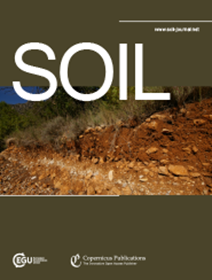Drivers of soil C quality and stability: Insights from a topsoil dataset at landscape scale in Ontario, Canada
IF 4.3
2区 农林科学
Q1 SOIL SCIENCE
引用次数: 0
Abstract
Abstract. Although soil C is a critical component of soil health, studies robustly exploring the agronomic and pedoclimatic effects on soil C are limited, especially at the landscape scale. Therefore, a dataset of 1511 samples from agricultural fields across Ontario was used to evaluate the impacts of agronomic and pedoclimatic factors on eight soil C indicators including chemistry and thermal stability of soil C using the programmed pyrolysis approach. Soil C quality and stability were largely controlled by the inherent soil characteristics such as soil texture. Significant interactive effects of cropping system and tillage intensity on soil C indicators were observed; however, the number of significant effects varied among the three soil textural classes. All soil C indicators were significantly different among the cropping systems for the coarse textured soils, but the cropping system differences decreased under medium and fine textured soils. From the pyrolysis analysis, the hydrogen index (HI) and oxygen index (OI) also confirmed that the soil C chemistry was influenced by the cropping system. For instance, orchard systems had stable pools of soil C whereas vegetable systems were associated with less advanced degree of soil C decomposition. Remaining soil management variables (cover crop use, tillage intensity, and organic amendments) had less influence on soil C indicators in all soil textural classes. Principal component analysis revealed a close association of soil C indicators with the mean annual precipitation (MAP) and cropping system; suggesting that the quantity and quality of soil C inputs associated with different cropping systems and increase in precipitation had a large influence on soil C. Our results confirm the significant effects of agronomic and pedoclimatic variables on chemistry, thermal stability, and composition of soil C pools, which have long-term implications on soil C storage, mitigating global climate change, and improving soil health.土壤C质量和稳定性的驱动因素:来自加拿大安大略省景观尺度表土数据集的见解
摘要。虽然土壤碳是土壤健康的一个重要组成部分,但对农艺和气候对土壤碳的影响进行深入探讨的研究却很有限,尤其是在景观尺度上。因此,研究人员利用来自安大略省农田的 1511 个样本数据集,采用程序热解方法评估了农艺和气候因素对 8 项土壤碳指标的影响,包括土壤碳的化学性质和热稳定性。土壤碳质量和稳定性主要受土壤质地等固有土壤特性的控制。耕作制度和耕作强度对土壤碳指标有显著的交互影响,但显著影响的数量在三个土壤质地等级之间存在差异。在粗质土壤中,所有土壤碳指标在不同耕作制度下都有显著差异,但在中质和细质土壤中,耕作制度的差异有所减小。热解分析、氢指数(HI)和氧指数(OI)也证实了土壤碳化学成分受种植制度的影响。例如,果园系统具有稳定的土壤碳库,而蔬菜系统的土壤碳分解程度较低。其余土壤管理变量(覆盖作物使用、耕作强度和有机添加剂)对所有土壤质地等级的土壤碳指标影响较小。主成分分析表明,土壤碳指标与年平均降水量(MAP)和耕作制度密切相关;这表明与不同耕作制度相关的土壤碳输入的数量和质量以及降水量的增加对土壤碳有很大影响。我们的研究结果证实了农艺和气候变量对土壤碳库的化学性质、热稳定性和组成的显著影响,这对土壤碳储存、减缓全球气候变化和改善土壤健康具有长远意义。
本文章由计算机程序翻译,如有差异,请以英文原文为准。
求助全文
约1分钟内获得全文
求助全文
来源期刊

Soil
Agricultural and Biological Sciences-Soil Science
CiteScore
10.80
自引率
2.90%
发文量
44
审稿时长
30 weeks
期刊介绍:
SOIL is an international scientific journal dedicated to the publication and discussion of high-quality research in the field of soil system sciences.
SOIL is at the interface between the atmosphere, lithosphere, hydrosphere, and biosphere. SOIL publishes scientific research that contributes to understanding the soil system and its interaction with humans and the entire Earth system. The scope of the journal includes all topics that fall within the study of soil science as a discipline, with an emphasis on studies that integrate soil science with other sciences (hydrology, agronomy, socio-economics, health sciences, atmospheric sciences, etc.).
 求助内容:
求助内容: 应助结果提醒方式:
应助结果提醒方式:


